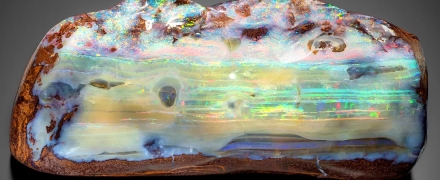open 10 am - 7 pm
laboratory is closed
How to distinguish natural opal from fake?

Let's start as usual with the definition. Opal is called amorphous silica having the chemical formula SiO2 * nH2O. One of the characteristic physical properties of this mineral is luminescence, the color of which depends on the color of the opal - white, blue and greenish in white samples, from green to brown in fire opals, and black opals play with all the colors of the rainbow under ultraviolet light.
Depending on the properties, types of opals are distinguished. Noble opal is considered a precious stone and is characterized by a play of colors, as well as a high degree of transparency. Ordinary opal, on the contrary, is not characterized by the presence of opalescence and is often opaque. Based on the color, fire and black opals are distinguished; they are most highly valued in the jewelry market. In addition to the above, there are also bolderopal, kahalong, hydrophan, hyalite and other varieties of opal, but our article is not about that.
How, then, to understand what we are buying - a natural stone or a parody of it?
First, pay attention to the distribution of colors in the stone, if it is natural, then it is better to refuse such a purchase, if the opal pattern is chaotic and does not repeat anywhere, then you can continue to study it. Twist the stone in your hands, if you can look at the opal from the side, then in the synthetic opal you will see the places where the layers were glued together, which look like even thin strips. Zoning of flowers in a stone can also indicate the origin of opal - the clearer the color transitions, the higher the likelihood that we are dealing with a fake. The transparency of the stone is also not unimportant. Take a closer look to see if the dark substrate is visible in the opal you are buying. Not many people know that even our language can help in defining crafts. How so? And it’s very simple - the natural opal does not stick to the tongue. And of course, pay attention to the price of opal. Too low a price should lead to suspicions of a fake.
All of these diagnostic methods are of course indirect. One hundred percent answer to the question of the origin of opal can give only a qualified gemologist.
В геммологической практике бывают весьма увлекательные случаи с диагностикой ювелирных вставок
Но помимо редкости цвета и высокой стоимости таких камней, многие розовые камни выделяются одной замечательной особенностью – они проявляют плеохроизм, то есть в зависимости от положения осмотра камня он может иметь дополнительные оттенки – оранжевый или пурпурный.
Currently, gemstones are produced by two fundamentally different technological methods - the High Pressure - High Temperature method (“HPHT”, High-pressure & High-temperature) and the Chemical Vapor Deposition (“CVD”, Chemical vapor deposition) method. The "HPHT" method is the most tested classical synthesis method, which can be used both carbon deposition on diamond from flux melts and catalytic reactions. In "CVD" synthesis, diamond growth occurs on a seed during carbon deposition mainly from a gaseous medium at relatively low temperatures and pressures.
Jewelry and precious stones are just such a category of goods, when buying which you need to pay attention to many criteria.
Sogdianite is a rather rare mineral and more often it can be found as a collection material (moreover, in systematic collections), and it is extremely rare in jewelry.






